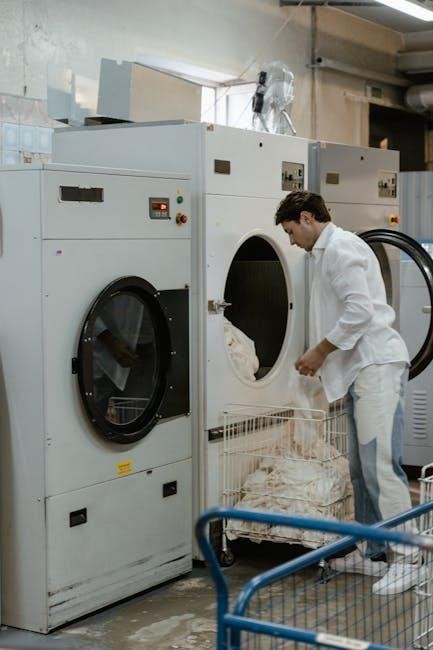Welcome to the guide on using the self-cleaning feature of your GE gas range. This article provides step-by-step instructions, safety tips, and maintenance advice to ensure efficient and effective cleaning. Learn how to prepare, operate, and care for your oven after the cycle for optimal performance.
What is Self-Cleaning and How Does it Work?
The self-cleaning feature on your GE gas range is a convenient way to maintain your oven’s cleanliness. It uses high heat, typically between 800°F and 900°F, to burn food residue into ash, which can then be easily wiped away. This process eliminates the need for harsh chemicals, making it a safer and more efficient method of cleaning. The oven door locks during the cycle to ensure safety, as the extreme heat could otherwise pose a hazard. Once the cycle is complete, the oven cools down, and the ash can be removed with a damp cloth. This feature not only saves time but also helps maintain your oven’s performance and appearance over time.
Why Use the Self-Cleaning Feature on Your GE Gas Range?
Using the self-cleaning feature on your GE gas range offers numerous benefits. It saves time and effort by eliminating the need for manual scrubbing and harsh chemicals. The high-heat cycle effectively breaks down tough food residue into ash, which is easy to wipe away after cooling. This method is also eco-friendly, as it reduces the use of chemical cleaners. Additionally, regular use of the self-cleaning feature helps maintain your oven’s performance and appearance, ensuring it continues to function efficiently. It’s a safe and convenient way to keep your oven clean, especially for those who cook frequently. By incorporating this feature into your maintenance routine, you can enjoy a cleaner, more hygienic cooking environment with minimal hassle.

Preparation for the Self-Cleaning Cycle
Before starting the self-cleaning cycle, ensure the oven is clear of racks and shelves, and protect surrounding areas from heat and residue. Turn off burners and ensure the cooktop is clean to avoid fumes.
Safety Precautions Before Starting the Cycle
Always turn off surface burners and ensure the cooktop is clean before starting the self-clean cycle to prevent fumes. Keep the kitchen well-ventilated to avoid inhaling fumes. Remove all racks and shelves, as they may warp during high heat. Protect surrounding areas with heat-resistant mats. Never use the oven for cooking during the cycle. Keep children and pets away, as the oven becomes extremely hot. Avoid using moist pot holders, as they can cause steam burns. In case of gas smell, do not light appliances or use electrical switches; evacuate and check for leaks. Ensure the oven door is closed securely to maintain safety and efficiency during the cycle.
Removing Racks and Shelves from the Oven
Before starting the self-cleaning cycle, open the oven door and carefully remove all racks and shelves. Use oven mitts to protect your hands from sharp edges or residual heat. Gently slide each rack out and place them in a sink filled with warm, soapy water to soak. This prevents food residue from hardening during the cleaning cycle. If any racks or shelves are particularly dirty, scrub them lightly before soaking. Ensure the oven is completely empty of accessories to allow proper airflow and even heating. Avoid leaving any utensils or trays behind, as they may warp or damage during high-temperature cleaning. Once removed, double-check the oven interior for any remaining items before closing the door and starting the cycle.
Protecting the Floor and Surrounding Areas
Before initiating the self-cleaning cycle, take steps to safeguard your floor and surrounding surfaces from potential damage. Place a large drop cloth, heavy-duty aluminum foil, or a heat-resistant mat on the floor in front of the oven to catch any debris or spills. Remove any flammable or heat-sensitive items, such as curtains or rugs, from the vicinity. Ensure the area around the range is clear to prevent accidental damage from extreme heat or fumes. For added protection, spread old towels or mats along the base of the oven to contain any residue that may fall during the cycle. This precautionary measure ensures a safe and mess-free cleaning experience, protecting both your home and appliances from harm.

Cleaning the Exterior of the Range Before the Cycle
Before starting the self-cleaning cycle, it’s essential to clean the exterior of your GE gas range to prevent any food residue from burning onto the surface during high heat. Begin by turning off the range and allowing it to cool completely to avoid burns. Use a gentle cleaner or a mixture of soap and warm water with a soft sponge or cloth to wipe down all exterior surfaces, including knobs, burners, and the oven door. Avoid harsh chemicals that could damage the finish. For tougher grime on burner caps and grates, soak them in warm soapy water, scrub gently, then rinse and dry. Use a microfiber cloth to prevent streaks and maintain the surface’s shine. Protect surrounding areas with old towels or a drop cloth. Finally, dry all surfaces thoroughly to prevent water spots. Avoid using abrasive materials and keep electrical components dry. Refer to your user manual for specific cleaning product recommendations from GE.

Step-by-Step Self-Cleaning Instructions
Remove racks and food residue, then set the self-cleaning controls, choose the duration, and start the cycle. Monitor the process for safety and proper completion.
Setting the Self-Cleaning Controls on Your GE Gas Range
To begin the self-cleaning process, ensure all surface burners are turned off and the oven is empty of racks and food. Locate the control panel and press the “Self Clean” button until “SC” or “Self Clean” appears on the display. Use the number pad or arrows to select the desired cleaning time, typically 2-4 hours, depending on soil level. Press “Start” to confirm and lock the oven door. The display will show “CL” or “Cleaning,” and the oven will begin heating to high temperatures to burn off residue. Ensure proper ventilation, as fumes may be released during the cycle. Follow these steps carefully to ensure a safe and effective cleaning process.
Choosing the Duration of the Cleaning Cycle
Selecting the right cleaning cycle duration is essential for effective results. GE gas ranges offer options ranging from 2 to 4 hours, depending on the level of soil inside the oven. For light food residue, a 2-hour cycle is sufficient, while heavier buildup may require the full 4-hour cycle. Use the control panel to choose the desired time, ensuring it matches the oven’s condition. Avoid selecting a longer cycle than necessary, as this can waste energy and potentially damage the oven. Always refer to your specific model’s manual for recommended durations, as variations may exist. Proper ventilation is crucial during the cycle, so open windows to prevent fumes from lingering. This step ensures a safe and efficient cleaning process tailored to your oven’s needs.
Starting the Self-Cleaning Cycle
Once prepared, start the self-cleaning cycle by pressing the “Self Clean” button on your GE gas range’s control panel. Select the desired cleaning time using the numeric keypad, ensuring it matches the level of soil inside the oven. Press “Start” to begin the cycle. The oven door will automatically lock to ensure safety during the high-heat cleaning process. You may hear clicking sounds or see lights flashing as the cycle starts. Do not attempt to open the oven door during this time, as it will remain locked until the cycle completes and the oven cools down slightly. Ensure the kitchen is well-ventilated, as fumes may be released. Avoid interrupting the cycle, as this could damage the oven or leave it in an unsafe state. Let the process run uninterrupted for best results.
Monitoring the Cycle and Safety Tips
During the self-cleaning cycle, monitor the process to ensure safety and efficiency. Keep the kitchen well-ventilated, as fumes may be released during high-heat cleaning. Avoid opening the oven door, as it will remain locked until the cycle completes and the interior cools slightly. You may hear clicking sounds or see lights flashing—this is normal. Do not interrupt the cycle, as it could damage the oven or create unsafe conditions. If you smell gas, immediately stop the cycle by turning off the oven and ventilation fan. Do not use phones or electrical switches near the oven. Always prioritize safety and follow the manufacturer’s guidelines to avoid accidents. After the cycle ends, let the oven cool before proceeding with post-cleaning care.

Post-Cleaning Care and Maintenance
After the self-cleaning cycle, let the oven cool completely before wiping down the interior with a damp cloth. Dispose of food residue safely and clean the exterior to maintain your GE gas range’s appearance and functionality.
Letting the Oven Cool Down After the Cycle
Once the self-cleaning cycle completes, it’s crucial to allow your GE gas range oven to cool down thoroughly. Turn off the oven and ensure all surface burners are also switched off. Keep the oven door closed during this time to prevent heat from escaping and to avoid accidental burns. The cooling process can take several hours, depending on the intensity of the cycle. Never attempt to open the door or start cleaning while the oven is still hot. Use this waiting period to prepare cleaning tools, such as gloves and a damp cloth, for the next steps. Patience is key to safely handling the oven post-cleaning.
Wiping Down the Oven Interior After Cleaning
After the self-cleaning cycle and cooling period, use a damp cloth to wipe down the oven interior. This step removes any remaining ash or residue left behind. Ensure the oven is completely cool to avoid burns. Start by wiping the roof, walls, and floor, working from top to bottom. For stubborn spots, a gentle scrub with a non-abrasive sponge or soft brush may be necessary. Avoid using harsh chemicals, as they can damage the finish. Once wiped clean, use a dry microfiber cloth to remove excess moisture and prevent streaks. This final step ensures your oven is spotless and ready for its next use. Regular wiping after cleaning helps maintain the oven’s condition and prevents residue buildup over time.
Disposing of Food Residue Safely
After the self-cleaning cycle, food residue is reduced to ash or a fine powder. Once the oven is cool, use a damp cloth to collect the residue, ensuring it doesn’t become airborne. Avoid inhaling the dust by keeping the area well-ventilated. Dispose of the residue in a sealed container or wrap it in paper before throwing it away in the trash. Never pour ash or residue down drains, as it can cause clogs or environmental harm. For eco-friendly disposal, check local guidelines for hazardous waste. Keep in mind that properly disposing of food residue helps maintain a clean and safe kitchen environment. Always handle the residue with care to prevent accidental spills or messes.
Maintenance Tips to Keep Your Oven Clean Longer
To maintain your GE gas range’s cleanliness, adopt a few simple habits. After each use, wipe down the oven interior with a damp cloth to prevent food spills from hardening. Clean the racks and shelves regularly, either by soaking them in hot soapy water or running them through the dishwasher. Avoid using abrasive cleaners, as they can damage the oven’s finish. For tougher stains, apply a mixture of vinegar and baking soda or use a gentle cleanser like Bar Keepers Friend. Always rinse and dry surfaces thoroughly before heating the oven again. By performing these routine tasks, you’ll reduce the need for frequent self-cleaning cycles and keep your oven in pristine condition for years to come.
